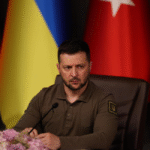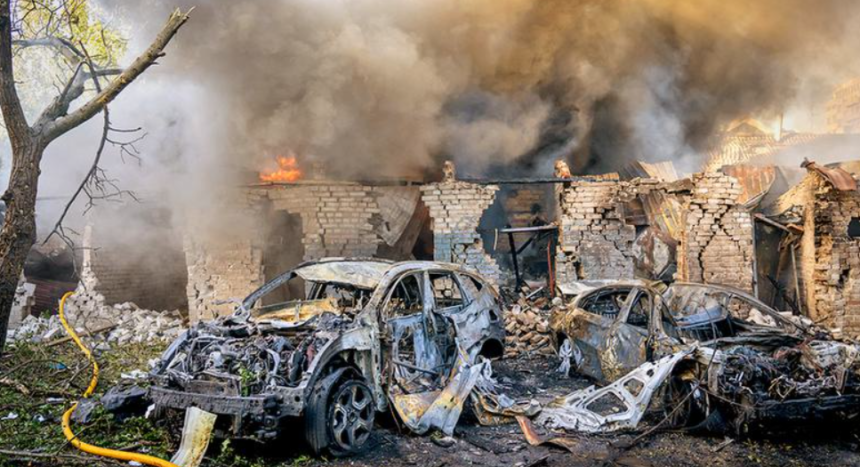As the conflict between Russia and Ukraine continues, southern Ukraine has become a new flashpoint with at least 13 civilians wounded in the latest Russian airstrikes. The strikes hit key cities and civilian infrastructure, including residential buildings, energy facilities, and transportation hubs. This escalation marks another chapter in the ongoing war that has destabilized the region and drawn international attention and condemnation. The toll on civilians, infrastructure, and global geopolitics continues to deepen as both nations remain locked in a bitter struggle.
In this detailed analysis, we will explore the immediate impact of the airstrikes on southern Ukraine, the broader context of the ongoing conflict, Russia’s objectives, Ukraine’s response, and the global community’s role in mitigating the crisis. Additionally, we will examine the humanitarian, political, and military dimensions that make this conflict one of the most significant in modern European history.
The Latest Airstrikes: What Happened?
In early 2024, southern Ukraine was rocked by a series of Russian airstrikes that targeted several key locations. The strikes, which began in the early hours, targeted residential areas, industrial sites, and energy infrastructure. According to local authorities, at least 13 civilians were wounded, some critically, as explosions ripped through the cities of Odesa, Mykolaiv, and Kherson, regions that have become hotspots in the ongoing conflict. Emergency services rushed to rescue those trapped under the rubble, while firefighters worked to extinguish fires caused by missile strikes.
The attacks come as part of a broader Russian strategy to weaken Ukraine’s morale and cripple its ability to resist militarily by targeting civilian infrastructure and essential services. Power grids, water supplies, and transportation systems have been prime targets throughout the war, aiming to create chaos and undermine the Ukrainian government’s ability to maintain normalcy.
A Struggle for Southern Ukraine
Southern Ukraine has strategic importance for both sides. For Ukraine, it is a crucial region for maintaining access to the Black Sea, which is vital for trade and supplies. Cities like Odesa serve as significant commercial ports and are critical for Ukraine’s economy. Mykolaiv, known for its shipbuilding, also has military significance. Kherson, located near the Crimean Peninsula, has become a pivotal battleground, particularly after it was recaptured by Ukrainian forces in late 2022. However, the region remains vulnerable to Russian air and missile attacks.
For Russia, controlling southern Ukraine offers not only military advantages but also potential economic benefits. A strong presence in southern Ukraine allows Russia to control key access points to the Black Sea, increase its influence in the region, and maintain pressure on Ukraine’s economy by restricting its exports. In particular, controlling the port of Odesa would give Russia leverage over Ukraine’s agricultural exports, especially grain, which are crucial for global food security.
Civilian Casualties and Humanitarian Crisis
The ongoing conflict has had a devastating effect on civilians. As of the latest airstrikes, 13 people have been wounded, adding to the tens of thousands of Ukrainian civilians who have been killed or injured since the war began in February 2022. These airstrikes have not only inflicted physical injuries but also psychological trauma, as residents live under constant fear of attack. Schools, hospitals, and residential buildings have all been hit at various points in the conflict, leading to widespread displacement.
The humanitarian crisis in Ukraine continues to worsen. Over 5 million Ukrainians have fled the country, with millions more internally displaced. The destruction of homes, public infrastructure, and essential services has created a situation where many Ukrainians are living without access to clean water, electricity, or adequate medical care. In the south, where fighting has been especially intense, local authorities struggle to keep up with the needs of the population, as attacks on power plants and water facilities have made life difficult for civilians.
International humanitarian organizations like the Red Cross and Médecins Sans Frontières (Doctors Without Borders) are working to provide aid, but the constant danger of airstrikes and shelling hampers their efforts. Hospitals in southern Ukraine are overwhelmed with casualties, and medical supplies are running low due to blockades and the destruction of supply routes.
Ukraine’s Response to the Escalation
In response to the latest wave of Russian airstrikes, Ukraine has intensified its defense measures. Air defense systems have been deployed in critical regions, and Ukrainian military officials have vowed to retaliate against Russian positions. President Volodymyr Zelenskyy, in a televised address, condemned the attacks and called on the international community to provide more military aid, particularly advanced air defense systems, to protect civilians from these brutal assaults.
Ukraine’s resilience in the face of Russian aggression has been remarkable. Despite being outgunned and facing a larger military force, Ukraine has managed to mount an effective defense, pushing Russian forces back from key areas, including the capital Kyiv and cities in the north and northeast. In the south, however, the fight has been more protracted, with both sides engaged in a fierce battle for control of strategic locations.
The Ukrainian military has also focused on disrupting Russian supply lines and launching counterattacks. In recent weeks, Ukraine has conducted successful operations in the southern regions, reclaiming some territory that had been under Russian occupation. However, the latest airstrikes show that Russia is far from giving up on its ambitions in southern Ukraine.
Russia’s Strategy and Objectives
Russia’s ongoing military campaign in Ukraine has evolved significantly since the initial invasion in February 2022. Initially aimed at a swift takeover of Kyiv and the toppling of the Ukrainian government, Russia’s strategy has shifted towards grinding attrition and territorial control in the eastern and southern regions of Ukraine. By launching airstrikes on southern Ukraine, Russia seeks to demoralize the Ukrainian population, disrupt the economy, and weaken Ukraine’s military capacity.
The airstrikes are part of Russia’s broader hybrid warfare approach, which combines military operations with cyberattacks, disinformation campaigns, and economic pressure. Targeting civilian infrastructure is a deliberate tactic designed to create chaos and force Ukraine to divert resources from the battlefield to address internal crises.
Another objective of the airstrikes is to undermine Ukraine’s international support. Russia is aware that the longer the conflict drags on, the more likely it is that Western countries may experience “war fatigue” and be less willing to provide military and financial assistance to Ukraine. By causing widespread suffering and damage, Russia hopes to pressure Ukraine into negotiating on Moscow’s terms.
The Global Response: Diplomacy and Sanctions
The international community has condemned Russia’s latest airstrikes, with many countries reaffirming their support for Ukraine. The United States, European Union, and NATO allies have continued to provide Ukraine with military aid, including weapons, ammunition, and training. The U.S. Department of Defense has announced plans to send more advanced air defense systems to help Ukraine protect its cities from missile and drone attacks.
Sanctions against Russia remain a key tool in the international response to the war. Since the invasion began, Western nations have imposed several rounds of economic sanctions targeting Russia’s energy sector, financial institutions, and political elites. These sanctions have aimed to cripple Russia’s economy and limit its ability to finance the war. However, Russia has adapted to some extent, finding alternative markets for its energy exports and developing closer ties with non-Western countries like China and India.
Diplomatic efforts to end the conflict have so far been unsuccessful. Negotiations between Russia and Ukraine stalled early in the war, and both sides remain entrenched in their positions. Russia demands recognition of its control over Crimea and the eastern Donbas region, while Ukraine insists on the restoration of its territorial integrity. Mediation attempts by countries like Turkey and international organizations like the United Nations have yet to yield a lasting ceasefire.
The Role of NATO and Western Military Aid
The role of NATO in the conflict, while indirect, has been crucial. Although Ukraine is not a NATO member, the alliance has provided substantial military and logistical support. NATO countries have supplied Ukraine with a wide range of weapons, including anti-tank missiles, artillery systems, drones, and intelligence-sharing capabilities.
NATO’s commitment has also involved bolstering the defenses of member states bordering Russia and Ukraine. The alliance has deployed additional troops and equipment to its eastern flank to deter any potential Russian aggression against NATO members, particularly in the Baltic states and Poland.
Western military aid has been instrumental in helping resist Russian advances. However, the scale of the conflict and the continued Russian airstrikes on civilian areas have raised calls for even greater support, particularly in terms of advanced air defense systems, fighter jets, and long-range missiles. Some NATO members have expressed concerns about escalating the conflict further, fearing a direct confrontation with Russia.
Humanitarian Impact and Long-Term Consequences
The humanitarian impact of the war in Ukraine cannot be overstated. The conflict has displaced millions of people, destroyed vital infrastructure, and created a refugee crisis that has affected neighboring countries and Europe as a whole. The constant threat of airstrikes, particularly in the south, has made daily life a struggle for civilians who face shortages of food, water, and medical supplies.
The long-term consequences of the war will be felt not only but across the globe. The destruction of Ukraine’s agricultural infrastructure, combined with the blockade of its ports, has disrupted global food supplies, particularly grain exports to Africa and the Middle East. This has contributed to rising food prices and increased the risk of famine in vulnerable regions.
Moreover, the war has reshaped global geopolitics, with tensions between Russia and the West reaching levels not seen since the Cold War. The conflict has also accelerated the shift towards a more multipolar world, with countries like China and India playing increasingly important roles in international diplomacy and trade.
Conclusion
The airstrikes are a stark reminder of the brutal realities of the ongoing war. With 13 more civilians wounded and cities like Odesa, Mykolaiv, and Kherson under constant threat, the human and economic toll of the conflict continues to rise. The international community must remain vigilant in its support for Ukraine, both militarily and diplomatically, while also addressing the humanitarian crisis that has unfolded as a result of Russia’s aggression.
As the war grinds on, the people of Ukraine are caught in the crossfire of a geopolitical struggle that shows no signs of abating. The resilience of Ukraine and the unity of its people remain critical in the face of adversity, as they continue to fight for their nation’s sovereignty and future. ALSO READ:- Can Kerala’s Policy to Limit Antibiotics Misuse Reduce Antimicrobial Resistance (AMR)? 2024





